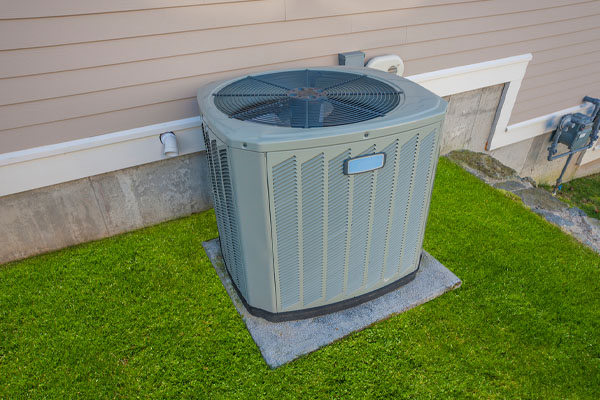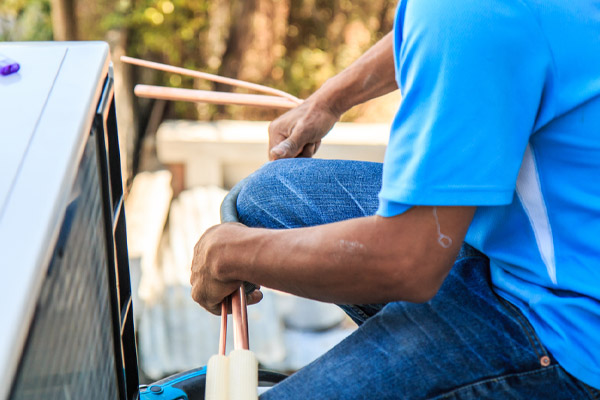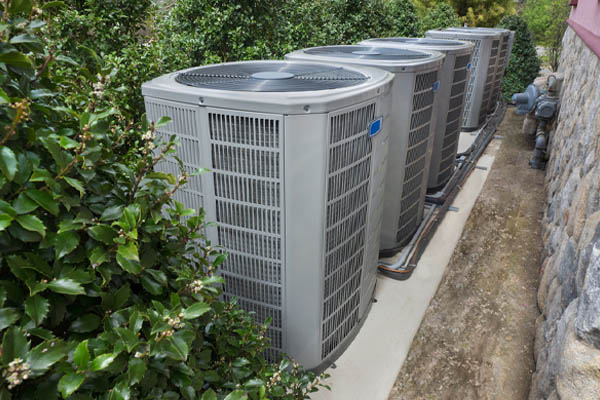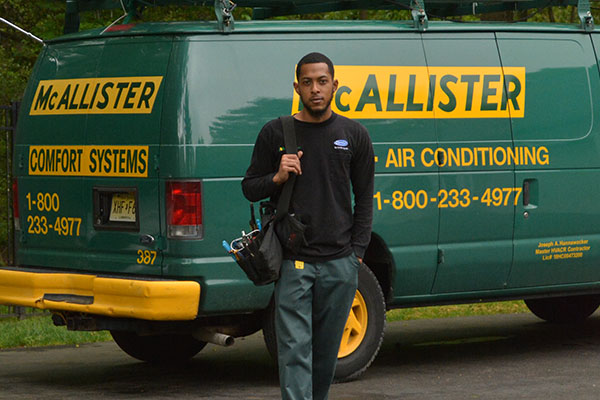How Much Clearance Is Necessary Around An Outdoor AC Unit?

Air conditioners need space to breathe. Adequate clearance and airflow help them perform better and last longer. That is why HVAC technicians need to adhere to industry standards when installing new AC systems. Homeowners should also remain vigilant about their existing outdoor AC units. Things, such as landscaping, might get too close over time. It is a good idea to check the perimeter year-round. The proper amount of space required for AC outdoor unit will depend on each situation. Read on to learn more about air conditioner clearance.
Why The Appropriate Amount Of Clearance Around An Outdoor AC Unit Is Important
Contents
HVAC systems need unobstructed airflow in and around the outdoor unit. Without proper clearance, they will not be able to get enough air. This can result in the following issues:
1. Reduced Air Conditioner Energy Efficiency

The cooling system can compensate for the lack of air by working harder. However, this will lead to more energy consumption and higher utility bills.
2. Sub-Optimal Indoor Cooling
The air conditioner will not produce enough cooling power for the home. Occupants may still feel warm despite turning the air conditioner on.
3. Air Conditioner Component Overheating
The hot air inside the outdoor unit will not be able to escape quickly. The components may overheat, resulting in HVAC repairs and premature equipment failure.
How Much Clearance Is Necessary Around An Outdoor Air Conditioning Unit?

The outdoor A/C unit is responsible for pushing the heat coming from inside the house to the outside environment. It can only do so effectively if there is enough airflow around the coils. The general rule is to clear at least one foot all around the unit. Some manufacturers may recommend more than this. Check the owner’s manual for specific guidelines or talk to your HVAC contractor. The kinds of obstructions in the immediate environment will also influence the minimum clearance requirements. Below are some of the most common concerns:
1. Construction Obstructions
These are structures around the property including walls and fences. If these have solid materials, then they will block the flow of air. Putting the outdoor unit near them is not a good idea. The AC will have a hard time cooling the house. The compressor might even suffer damage due to long-term airflow restriction. It is essential to keep a separation of at least two feet from these obstructions. The distance makes it easier to draw air into the unit and cool the hot coils.
2. Landscaping Obstructions
A lot of people do not like the look of the outdoor AC unit. They might feel that it clashes with the design of the house. They could even go so far as to hide the unit by planting more shrubs and adding potted plants around it. While this could create a more aesthetic appearance outside, it could cause problems inside the house. Restricted airflow can result in HVAC system inefficiency, poor performance, and component damage. It would be prudent to maintain a two feet clearance around the unit. Since plants can grow quickly, homeowners should trim the perimeter on a regular basis.
3. Mechanical Obstructions
These are the most problematic obstructions for the outdoor AC unit. Examples include vents for heating appliances, kitchen exhaust, and clothes dryers. Putting these too close to the unit can cause airflow issues. It could even be dangerous, as in the case of oil tank fill valves and gas vents. There needs to be a significant distance for safety. Experts recommend four feet at the minimum but keeping them as far away as possible is the best option. HVAC installers will try to find a suitable area in another part of the property.
Outdoor Air Conditioner Unit & Overhead Clearance
Keep in mind that the top of the unit is crucial as well. Once the sides are clear, shift your focus to the things above the AC. Many of the current models discharge hot air upwards. If anything blocks this flow, then the hot air will go back down and cause overheating. Common causes include debris such as dry leaves and branches. Nearby shrubs can also grow to the extent that they cover the top of the unit. Sometimes decks are to blame for issues if built above the outdoor AC. The spacing between the top and the deck boards might be inadequate. Decorative covers and low roof overhangs can become problematic as well. An overhead clearance of 8ft is the minimum recommendation.
Spacing Between Two Outdoor Condensing Units

If there are two or more outdoor units, then professional installers must consider their distance carefully. The units cannot sit too closely because they will impede each other’s air intake. In some cases, one might suffer from overheating if it pulls in the hot air from the other unit. The air conditioner will have a hard time cooling the house under this condition. A minimum spacing of 4ft is crucial.
Spacing For An Outdoor Heat Pump
Heat pumps can be effective heating and cooling options in mild climates. The outdoor equipment must have enough clearance as well. Homeowners must be particularly vigilant during winters because snow and ice can cover it. The coils should always remain above the snowpack. Removing snow around the heat pump needs to become a habit for optimum system efficiency. Sometimes snow can get inside the unit making it necessary to clean things up. Those who are wary about doing the task themselves can call HVAC technicians for help.
Site Inspection Before HVAC Installation

Before installation, HVAC technicians will make it a point to visit the site and locate ideal spots for the outdoor unit. They will familiarize themselves with the layout of the property and search for possible challenges to system operation. All of these will help them determine the proper clearance on all sides. Their findings will allow them to design and install the unit for the best results.
Homeowners can ask their HVAC contractor about clearance requirements prior to installation. By taking a more active role, they can learn more about the topic while helping to ensure adequate spacing. Costly errors and performance issues are less likely to happen.
Conclusion
Sufficient AC clearance is vital for a successful HVAC system installation. Hire certified professional air conditioning technicians so that you will not have to worry about problems down the road. Their expertise will guarantee the best possible outcome through careful planning and excellent execution.
Call McAllister Energy For Superior Heating & Cooling Solutions

McAllister Energy offers high-quality HVAC services in Camden County, New Jersey. We hire only the best professionally certified technicians who conduct superior heating and cooling services. Some of our HVAC services include HVAC maintenance, heating and cooling installations, repairs, ductless systems, and much more. All our techs provide accurate HVAC services on time, every time.
Our company guarantees affordable heating and cooling service rates. Our maintenance services can increase your home’s comfort, energy efficiency, and cost-effectiveness. We can also provide you with a highly energy-efficient HVAC replacement system that fits your budget. Your satisfaction is important to us, so all our work comes with a guarantee. Book a service appointment with McAllister Energy today. We provide free, in-home estimates.
You can click here to contact us now or call us at (856) 665-4545 to find out more!